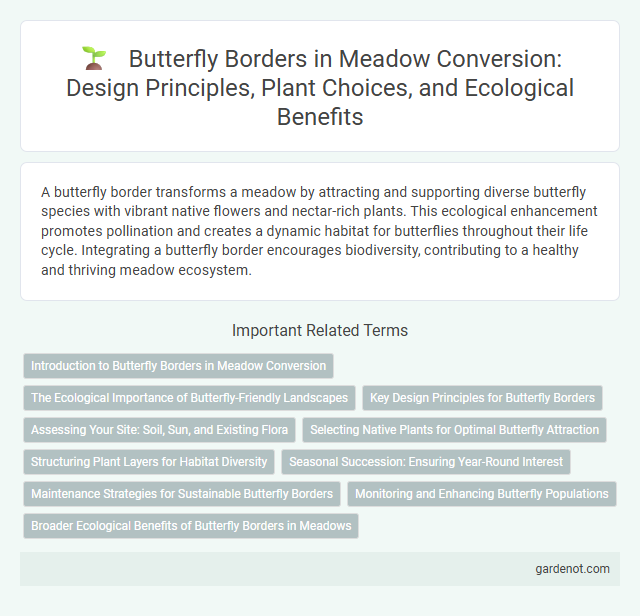A butterfly border transforms a meadow by attracting and supporting diverse butterfly species with vibrant native flowers and nectar-rich plants. This ecological enhancement promotes pollination and creates a dynamic habitat for butterflies throughout their life cycle. Integrating a butterfly border encourages biodiversity, contributing to a healthy and thriving meadow ecosystem.
Introduction to Butterfly Borders in Meadow Conversion
Butterfly borders in meadow conversion create diverse habitats by planting nectar-rich flowers that attract various butterfly species, enhancing local biodiversity. These borders support pollinators such as swallowtails, fritillaries, and painted ladies by providing essential larval host plants and adult nectar sources. Incorporating butterfly borders increases ecological resilience and promotes sustainable garden ecosystems.
The Ecological Importance of Butterfly-Friendly Landscapes
Butterfly-friendly landscapes are vital for supporting pollinator populations by providing diverse nectar sources and host plants essential for butterfly lifecycles. These habitats enhance biodiversity, improve ecosystem resilience, and promote natural pest control by attracting beneficial insect species. Integrating butterfly borders in meadow conversions fosters ecological balance and contributes to the conservation of threatened butterfly species.
Key Design Principles for Butterfly Borders
Key design principles for butterfly borders prioritize planting native wildflowers and grasses that provide nectar and host plants throughout the butterfly lifecycle. Incorporating a diversity of bloom times from early spring to late fall ensures continuous food sources, supporting a robust butterfly population and enhancing biodiversity. Strategic placement of sunlit areas, sheltering shrubs, and avoidance of pesticides creates an optimal habitat, promoting butterfly reproduction and survival.
Assessing Your Site: Soil, Sun, and Existing Flora
Assessing your site for a butterfly border involves analyzing soil composition, sun exposure, and existing flora to create optimal conditions for butterfly habitats. Well-drained, nutrient-rich soil combined with at least six hours of direct sunlight daily supports the growth of nectar-rich plants and native host species essential for butterfly life cycles. Surveying current vegetation helps identify invasive species to remove and existing beneficial plants to preserve, enhancing biodiversity and ensuring successful meadow conversion.
Selecting Native Plants for Optimal Butterfly Attraction
Choosing native plants such as milkweed, coneflowers, and black-eyed Susans enhances butterfly attraction by providing essential nectar sources and larval host plants. Native flora supports local butterfly species' life cycles more effectively than non-native varieties, promoting biodiversity and ecological balance. Incorporating a diverse range of native plants ensures continuous bloom throughout the season, maximizing habitat suitability and butterfly visitation rates.
Structuring Plant Layers for Habitat Diversity
Butterfly borders in meadow conversion utilize a variety of native flowering plants structured in multiple layers, including low ground covers, mid-height perennials, and taller nectar-rich shrubs, to create diverse microhabitats essential for different butterfly species. This stratified planting supports larval host plants, provides shelter from predators, and ensures continuous nectar sources throughout the butterfly lifecycle. Effective layering enhances ecological functions, promoting increased pollinator diversity and overall habitat resilience.
Seasonal Succession: Ensuring Year-Round Interest
Butterfly borders designed for meadow conversion prioritize seasonal succession by incorporating a diverse mix of native wildflowers and nectar-rich plants that bloom sequentially from early spring to late autumn. This strategic planting ensures continuous habitat and food sources for butterfly species throughout the year, promoting biodiversity and sustained pollinator activity. The use of perennial and biennial plants enhances the border's resilience and visual appeal across changing seasons.
Maintenance Strategies for Sustainable Butterfly Borders
Effective maintenance strategies for sustainable butterfly borders prioritize selective weeding to reduce competition while preserving native nectar plants essential for butterfly life cycles. Seasonal pruning and mulching help maintain plant vigor and soil moisture, promoting a diverse and thriving habitat. Incorporating organic pest management minimizes chemical use, supporting ecological balance and butterfly population health.
Monitoring and Enhancing Butterfly Populations
Regular monitoring of butterfly populations within butterfly borders provides critical data on species diversity and abundance, enabling targeted conservation efforts. Implementing native nectar-rich plants supports breeding and feeding habitats, enhancing lifecycle success rates. Integrating habitat connectivity measures fosters genetic diversity and resilience against environmental changes.
Broader Ecological Benefits of Butterfly Borders in Meadows
Butterfly borders in meadow conversions enhance biodiversity by providing essential nectar sources and habitats for various pollinators, including butterflies, bees, and other beneficial insects. These borders contribute to ecosystem resilience, supporting natural pest control and promoting plant diversity within meadow landscapes. Incorporating butterfly borders fosters habitat connectivity, which is crucial for wildlife movement and overall ecosystem health.
Butterfly border Infographic

 gardenot.com
gardenot.com